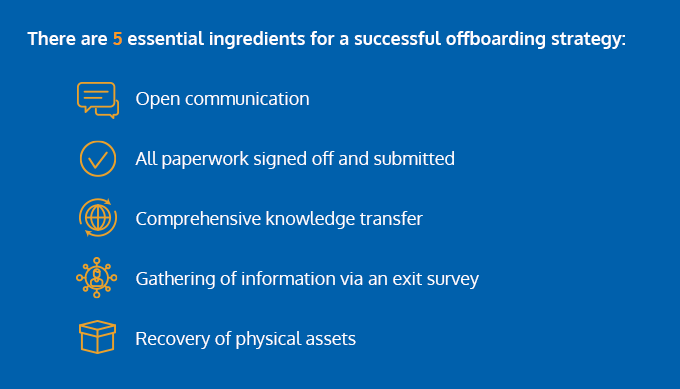A fond adieu: 5 tips for smooth offboarding
Once upon a time, a valued employee would resign, complete their notice period, walk out the door amidst a flurry of emotional farewells, and rarely be heard from again – ...

Once upon a time, a valued employee would resign, complete their notice period, walk out the door amidst a flurry of emotional farewells, and rarely be heard from again – except perhaps through their personal connections with various former colleagues. Employers haven’t traditionally thought much about “offboarding” – that is, the process that kicks into gear when people leave the organisation. However, much like onboarding is increasingly recognised as a key component of talent management, structured offboarding is becoming popular at the other end of the employee journey.
2 key reasons why smooth offboarding matters
Firstly, former employees today don’t simply disappear. People remain connected – albeit sometimes tenuously – through professional networks like LinkedIn. More than ever before, employer reputations are on the line – or more correctly online – and departing employees will speak their minds about former employers on Glassdoor, Facebook, or any number of social channels. How your organisation treated them on their way out the door can play a key role in determining whether reviews will be positive or negative.
Second, talent in many industry sectors is scarce, so “boomerang” or returning employees can be a lifesaver for employers. Who wouldn’t welcome back an employee who has previously proven their worth and who left the organisation on positive terms? One survey[1] indicated that almost 2 in 3 Australian companies have re-hired a former employee who left the organisation voluntarily. A New Zealand survey[2] revealed that more than half of NZ employers have rehired former employees, and 9 in 10 rated the performance of these employees as above average. Again, the smooth offboarding process might just determine whether an ex-employee is interested in returning as an employee, contractor or freelancer.
What’s required?
For departing employees, the difference between a positive and negative offboarding experience can often be determined by the smallest of details. For employers, it’s vital to understand what’s happened, and whether anything could’ve been done to prevent the exit. Employers must also be mindful of what’s walking out the door with the employee – specifically, their knowledge.
To turn a potentially negative experience into a positive experience for both parties, a structured, systematic process is called for.

Here are those 5 ingredients in detail:
Open the communication channels
Rest assured, when an employee quits, others know about it – instantly. The longer a manager withholds announcements the higher the chance that gossip and misinformation will spread. Before you do make the announcement, clarify:
- When the employee’s last day will be
- Who will be taking over their responsibilities in the interim
- Determine the timeframe for obtaining a job requisition for the departing employee’s replacement.
Prepare clear answers to questions about the employee’s departure and plans for replacement.
Complete the paperwork
HR and payroll teams should clearly communicate all necessary administrative details to the departing employee, including post-employment payments, unused leave payouts, and reminders about non-disclosure or non-compete agreements.- Commence knowledge transfer
As soon as an employee hands his or her notice in, it’s time to consider knowledge transfer. The organization records, stores, and prepares the departing employee’s accumulated knowledge for their replacement through this process. Comprehensive documentation of processes, projects, and other crucial information is essential when there is no overlap between the departing employee and their replacement. Whether in-person or in a handover document, the existing employee might be able to provide insights around:
- The day-to-day tasks of the role and what the priorities are
- Project updates
- Critical files that a successor will need to know about and have access to
- Identify key contacts, both internal and external, who require notification about the transition.
- Assess the need for system-specific training for new hires.
- Gather information with a staff exit survey
An exiting employee can be a valuable source of information for HR. The easiest way to obtain this information is through an exit survey. Exit surveys reveal the reasons behind employee departures and pinpoint areas for improving company policies, practices, and culture. It can also reveal recurring turnover issues, allowing for targeted action. They key word here is “action”. Avoid simply filing survey results away in a lever arch folder, where they’ll remain unseen and unaddressed. Instead, take proactive steps to address recurring issues and implement improvements.
Here are some common questions an exit survey can ask:
- Did the job match your expectations when you first joined the organisation?
- Did you have the resources, equipment and training necessary to do your job effectively?
- Is there anything we can do to convince you to stay?
- How was the relationship with your direct manager?
- What is the biggest thing we can do to improve as an organisation?
- Would you recommend us to job-seeking friends? Why or why not?
- Recover physical company assets
Recover all company-issued items, including phones, laptops, keys, security passes, and uniforms. Close corporate credit cards or expense accounts associated with the departing employee. On the final day, IT should revoke system access.
A send-off to remember
All departing employees, regardless of their notice period, merit respect and dignity. A structured smooth offboarding process can ensure this occurs.
Last impressions count almost as much as first impressions – so while the exit of a well-liked and trusted employee will be bittersweet, always leave the door open for a return. On that note, here’s one final tip: instead of referring to them as “ex-employees”, start referring to them as “alumni” and aim to keep in touch – they may just be your greatest advocates out in the big wide world.
ELMO Survey enables organisations to conduct and manage staff surveys throughout all points of the employee lifecycle, including during the offboarding process. ELMO Survey provides access to a HR Survey Library to compare results against other organisations in your industry, across benchmarked data points. It also allows for easy comparison of results by key demographics such as age, gender, location, division, and tenure. Contact ELMO Cloud HR & Payroll to see how your organisation stands to benefit.
[1] Robert Half survey of 100 Australian HR Managers, 2016
[2] “The Boomerang Phenomenon: Taking Flight in the New Economy”, Hudson NZ report, 2011
 HR Core
HR Core 









